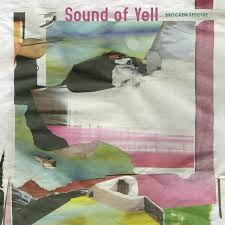A "brocken spectre" is an enormous, magnified shadow cast onto clouds or mist by a person standing on top of a mountain top or ridge, with the sun shining directly behind them. This inversion of a wanderer projected onto a sea of fog – an optical illusion where depth perception becomes tricky – is often surrounded by halo-like rings of coloured light (called a ‘glory’), in an uncanny fusing of the celestial and the terrestrial.
In many ways, it’s an apt name for Stevie Jones’s debut album as Sound Of Yell, which, over eight fluently orchestrated songs, conjures a quiet magic and subtle psychedelic haze from a largely organic palette. Jones has a name as one of the most sought-after collaborators in Scotland, having worked with the likes of Ali Roberts and Aidan Moffat, and also as a sound designer for the National Theatre of Scotland. In particular, Jones’s restrained, fluid double bass can be heard on Roberts’ <a href="https://www.youtube.com/watch?v=MoqJK01RoUc" target"out">’Too Long in This Condition’ (Roberts repays the favour here, playing hurdy gurdy on Brocken Spectre).
Brocken Spectre‘s unhurried, slowly unfurling sheen masks deceivingly complex undercurrents which flit between time signatures and countermelodies. As you might imagine from a cast that includes Stevie Jackson (Belle And Sebastian; harmonica), Norman Blake (Teenage Fanclub; vocals), Alex Neilson (Trembling Bells, Death Shanties; drums and percussion), Peter Nicholson (The One Ensemble; cello), Aby Vuillamy (National Jazz Trio of Scotland; musical saw, vocals) and sound artist Kim Moore (Wolf; viola, vocals), the playing on this record is fluent, intuitive and frequently beautiful.
In a way, this an idiosyncratically Glaswegian record, with hints of rolling Scots folk song picked out with a collaborative exuberance that touches on jazz, library music, and wordless, choral song. There’s something special about the music that Glasgow’s experimental-folk communities continue to produce – collaborative, improvisational and outward-looking – this record is very much the match of the output of its contributors.
More than once I was reminded of Basil Kirchin’s freeform library music experiments – particularly ‘Abstractions Of The Industrial North’ – in the intuitive way that Jones’s compositions pick up pace and vibrancy; as elements coalesce and carry forward on a giddy, infectious march. Jim O’Rourke’s recent work – particularly on ‘The Visitor’ – might be another touchstone, sharing a similar talent for augmented picking patterns that threaten never to resolve over slowly rolling viola, clarinet and harmonica drones. Like O’Rourke –and perhaps Cornish-based guitarist David A Jaycock too– Jones’ knack for subtly weird shifts of melody and time might be partly drawn from his past (and recently revived) life in post-rock, as the bassist for Glasgow’s El Hombre Trajeado alongside RM Hubbert and others.
The orchestrations on these songs are always full and finely textured, yet rarely cluttered. Indeed, there’s a special quality to them in the way the generous arrangements allow each player room to breathe, whilst hanging together as a cohesive whole. Alex Neilson’s drumming is as expressive and sympathetic as ever; his flutters and fills an ideal foil to the push and pull of Jones’s compositions. Vuillamy’s saw playing on ‘Sated Eyrie’ is subtle and otherworldly; the notes occasionally coalescing with Moore’s viola to produce something sweet and ghostly over the semi-ritualistic chug of drums and bowed strings.
Brocken Spectre‘s 8 minute centrepiece ‘Iguacu’ – written after visiting the titular national park and waterfalls in Brazil while visiting his expat friend and fellow fingerstyle guitar player Chris Mack – is perhaps the highlight of the record. Pops and burbles of percussion and double bass wind through a slowly unfurling guitar melody, as the overtones of bowed cymbals slip into a brief snatch of wordless vocals. The song builds with layers of piano, drums and clarinet, but refuses to lapse into predictable linearity, instead offering up full stops and false starts each time it seems to have built up a head of steam (or, in this context, spray, perhaps); and finally evaporating into nothing but the sublime resonance of instruments humming and thrumming to a still.
Jones’s production on Brocken Spectre is sympathetically done – clear, close and adorned with nothing but natural reverb, it documents every scrape, hum and thud of body on instrument as an organic, heaving whole. Recorded to 2" tape at Chambers Studio and at Chem 19 in Glasgow, then mixed by Jones at the Kinning Park Complex – a creative hub in an old school on the south side of the city – there’s echoes of Steve Albini’s production (and at times the arrangements) on the Nina Nastasia records of the early 2000s.
Brocken Spectre is an invigorating, innovative and addictive album that I can imagine revisiting time and again – and one of my favourite records of the year. Here’s to many more Sound(s) Of Yell.
<div class="fb-comments" data-href="http://thequietus.com/articles/16751-sound-of-yell-broken-spectre-review” data-width="550">


